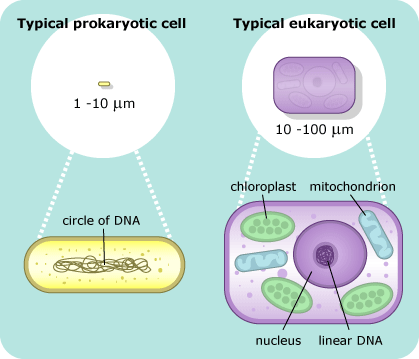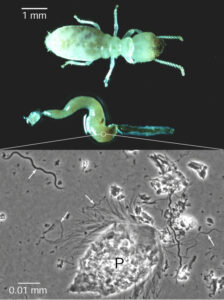Margulis’ observations weren’t new to science; many researchers before her1 had peered through a microscope and noticed the striking similarities between mitochondria and bacteria. Margulis learned from one of her professors that some of those observers, back in the 1880s, had come up with a hypothesis about why mitochondria and bacteria looked so much alike. This was the first time Margulis heard about the “crazy” hypothesis that would shape her career and revolutionize scientists’ understanding of how complex cells evolved.
WHAT ARE PROKARYOTES AND EUKARYOTES?
Prokaryotic cells are relatively simple. They are small, and their DNA is circular and floats freely inside the cells. All bacteria are prokaryotic cells.
Eukaryotic cells are more complex. They are larger, and their DNA is arranged in linear chromosomes and kept inside a nucleus. Eukaryotic cells have some organelles that prokaryotic cells don’t have — like mitochondria. All plants, fungi, and animals (including humans!), as well as many single-celled creatures like amoebae, are made up of eukaryotic cells.

What was this crazy idea? Margulis’ professor explained that over the last eighty years, a number of scientists had proposed that eukaryotic cells evolved when one bacterium (a prokaryote) engulfed another and the two began living together. Over many generations, and through many smaller changes, the engulfed cell evolved into an organelle, like the mitochondrion. According to this idea, mitochondria look and act so much like bacteria because they once were bacteria!

This ecological relationship is called endosymbiosis. “Endo” is Greek for “within” and “symbiosis” is Greek for “living together” — so endosymbiosis means one organism living inside another. In Margulis’ day, scientists knew that many organisms have endosymbionts — like termites, which depend on microorganisms in their guts to digest wood — but nobody thought that this relationship could evolve to be so close that the two would become a single organism.
Each of the times that the endosymbiotic hypothesis was proposed, most of the scientific community thought it sounded too far-fetched. Two different organisms coming together to form a single one? Ridiculous! It would never have worked!
To Margulis, the idea didn’t sound crazy, but as a graduate student, she didn’t have much time to mull it over either. She was busy thinking about genetics and working on her Ph.D. research at UC Berkeley. As we’ll see, however, her research and her observations of another organelle, the chloroplast, would lead her back to this strange idea.
1Notably, Konstantin Mereshkovsky in 1905.
